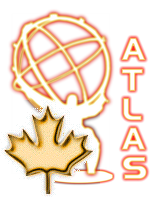 Skip to Content
Skip to ContentWELCOME About HEP
Research
Graduate Studies
Theses
Employment
Contact Info
HEP GROUP
Personnel
Computing
Media Releases
Events
Links

Research Projects |
|
Members of the High Energy Physics Group participate in several ongoing experimental collaborations, listed below. Research in these areas is also a focal point of our graduate programs in experimental particle physics and accelerator physics. The ATLAS Experiment at CERN
The ATLAS experiment is exploring the high energy frontier at the Large Hadron Collider at CERN. Operations commenced in 2009, and since March 2010 data taking has continued with proton-proton collisions at a record 7 TeV. ATLAS is one of the highest priority projects for particle physics in Canada, and the UVic group has been involved since its inception, from construction to current physics analysis. More information. The BaBar Experiment at SLACThe BaBar experiment at the PEP-II asymmetric e+e- collider at SLAC has, through precision studies of B-meson decays, provided a detailed picture of CP violation in nature (an important symmetry relating properties of matter and antimatter). Members of the UVic group have held prominent positions within the collaboration and, while data taking ceased in 2008, the physics analysis is ongoing. More information. The T2K Experiment
Theorectical PhysicsSee the Theoretical Physics Home Page for more information on the study of theoretical physics at the University of Victoria. HEP Research ComputingThe HEP Research Computing Group at UVic is actively engaged in a variety of projects for the analysis of data from particle physics experiments as well as providing advice to researchers in other fields. Our areas of expertise include high-speed networks, management of large scale data storage, virtualization, grid and cloud computing. More information. The Linear Collider DevelopmentResearch dealing with a future 500 GeV e+e- Linear Collider. Seen as an important counterpart to LHC, the Linear Collider will help in understanding the Higgs boson as well as hopefully making discoveries beyond the standard model. More information. JDEM and STARCaL Facilities at UVicOur laboratory in the Elliott building was used for the construction of the ATLAS cryogenic feedthroughs and is being used for R&D on an advanced detector readout system for a Time Projection Chamber for a future Linear Collider. We also have access to the excellent infrastructure available at the TRIUMF laboratory. We perform data analysis in Victoria using a 50 cpu beowulf linux cluster with 7 TB of disk, and using the IBM Linux Blade Cluster in the UVic computing center. ThesesThe theses of former students can be found here. PublicationsSee SPIRES for list of publications from UVic Physics & Astronomy, including a comprehensive list of publications by members of the HEP group. |
 The T2K experiment is a long baseline neutrino oscillation experiment from JPARC to the SuperK water Cerenkov detector in Japan, designed to study muon-neutrino to electron-neutrino oscillations and muon-neutrino disappearance. The UVic group has been heavily involved in work on the ND280 near-detector, and data taking started in 2010.
The T2K experiment is a long baseline neutrino oscillation experiment from JPARC to the SuperK water Cerenkov detector in Japan, designed to study muon-neutrino to electron-neutrino oscillations and muon-neutrino disappearance. The UVic group has been heavily involved in work on the ND280 near-detector, and data taking started in 2010.